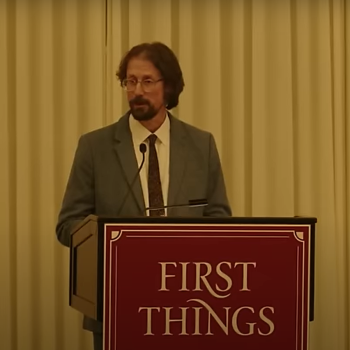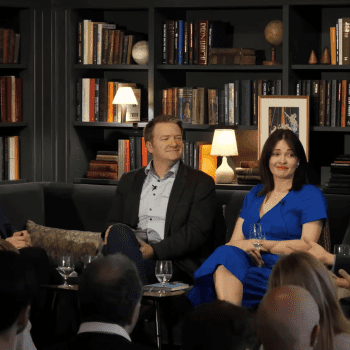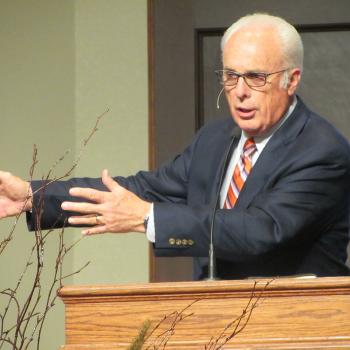
Picture this: Your wife of two decades has just filed for divorce. You’ve battled lifelong clinical depression. Your family is dysfunctional and impossible to talk to. You have no close friends to confide in. You’re on the edge of a crisis.
Now, let us suppose, for our purposes, that you are not a churchgoing man. Let’s suppose that you don’t know how to act in church, you don’t know how to talk to church people, and you worry about feeling awkward, confused, and out of place. But let us further suppose that on this particular morning, for reasons you can’t quite explain, you’ve found yourself in a church parking lot. Because why not? It’s your last try.
Or, picture this: Your boyfriend of two years has just confessed he never loved you “like that,” and he’s definitely not in a hurry to take responsibility for the baby you’ve just realized you made together. Your family is dysfunctional and impossible to talk to. You have no close friends to confide in. You’re on the edge of a crisis.
Now, let us suppose, for our purposes, that you are not a churchgoing girl. Let’s suppose that you don’t know how to act in church, you don’t know how to talk to church people, and you worry about feeling awkward, confused, and out of place. But let us further suppose that on this particular night, for reasons you can’t quite explain, you’ve found yourself browsing a church website. Because why not? It’s your last try.
Our man in the parking lot gets out of the car and walk up to the door. A sign catches his eye. Large letters at the top read “WELCOME.” He keeps reading: “Masks are required at all times in this building. Please maintain six feet distancing. Please do not enter this building if you are experiencing any cold or flu-like symptoms, including runny nose, cough, or fever.”
Our girl on her phone scrolls past the “WELCOME” banner and clicks on the tab reading “COVID guidelines.” “We require that all visitors wear masks and maintain six feet distancing at all times. If you are experiencing cold or flu-like symptoms…”
Now let me ask you, the Christian reader, or for that matter you the basically human reader: Do you see a problem here? If not, let me suggest that you should.
Let me suggest that churches are for something, and that “something” that churches are for is intimately linked with physical interaction, including face-to-face conversation and tangible gestures of care. Let me further suggest that the church cannot adequately carry out that “something” as long as her members are forced to communicate said care by sign language and expressive eyebrow-raising, on the other side of the pew from the person who needs it most. Let me still further suggest that churches who are privately acknowledging this and doing the sane and sensible thing are publicly making hypocrites of themselves.
I’m not trying to be controversial in saying this. I’m merely saying something we all took for granted until about five minutes ago, when apparently it became synonymous with “Loving thy neighbor” to insist we should neither smile at, nor hug, nor in any way tangibly comfort said neighbor, even if said neighbor is in far more need of a hug than a six-feet distancing mandate.
The speed with which some people have rushed to embrace this state of affairs as our country’s “new normal” astonishes and disturbs me. I was most struck while reading David French’s TIME article on Donald Trump’s COVID response—a weakly argued, tediously scolding article in general, as has become par for the course with French these days, but this bit in particular left my jaw on the floor:
The administration’s disregard of basic health protocols, including both masking and social distancing was on full display at the White House ceremony introducing Amy Coney Barrett to the American people. For a nation now accustomed to prudent masking and limiting close personal contact (especially indoors), the images were shocking. Unmasked leaders, including people with potential health vulnerabilities, were hugging and close-talking. [emphasis added]
The horror! The horror! In all seriousness, this is the point at which I’d like to raise my hand, politely clear my throat and say “Excuse me, but I’m not accustomed to these things. And I’m most definitely not alone.”
Unfortunately, this is a conversation we are increasingly not being allowed to have, because chirpy, unquestioning assent to masking and distancing mandates is coming to be seen as the pons asinorum of the conversation, the “Of course all reasonable people would agree” of the debate. Any suggestion that there are serious downsides to such mandates is met with shock, as if only a wild-eyed deplorable could suggest such a thing. Or so goes the narrative. The reality is not so conveniently dismissable, because the reality is that all manner of people across age, race and social status are not happy with the “new normal.” Parents are tired of disorienting their small children by forcing them to mask up at school and interact with masked-up teachers, who are likewise tired of having to teach without using their faces. Hearing-impaired people are tired of not being able to read lips while simultaneously having their own hearing aids dislodged. Pastoral counselors and secular therapists alike are tired of having to muddle through intimate sessions without anyone being able to see anyone else’s expressions. The list goes on. (For a lighter take on the absurdity of it all, I’d point people to Douglas Murray’s droll Englishman-in-New-York travel notes, with the caveat that you must be capable of appreciating satire in order to enjoy. Otherwise, if you can’t even understand how people might laugh about this, don’t bother.)
But you won’t read any nuanced admission of these counter-considerations in the media. Even major conservative-leaning media has been a disappointment here. See, for instance, Chris Christie’s recent painfully shallow (and just downright painful) piece at the Wall Street Journal about his hospitalization with the virus. Here he is in full finger-wagging mode:
When you get this disease, it hits you how easy it is to prevent. We are asked to wear cloth over our mouth and nose, wash our hands and avoid crowds. These minor inconveniences can save your life, your neighbors and the economy. Seldom has so little been asked for so much benefit.
Well garsh Guv’nor, when you put it that way…
Of course, this is where aggressive pro-masking rhetoricians say “Oh, but I thought you wanted the economy to re-open?” Implication: You can have a functioning society, or you can have strict masking/distancing mandates. Pick one, or else we will ask what it is you “really want.”
I can answer that. What we “really want” is normalcy. What we “really want” is basic human connection. What we “really want” is human conversation, human comfort, human touch. What we “really want” is to see the stamp of the divine in the fullness of its glory on the human face.
Lest I be misunderstood, I’m not saying people concerned about the virus shouldn’t be accommodated. Someone could point to my opening examples and counter “What about the new visitor who’s scared of getting sick, are you saying he should be told to suck it up?” Of course not. What I am saying is that the ideal default should be switched: Let normalcy be the default, make case-by-case exceptions for people who are uncomfortable. Perhaps churches could provide tags for more nervous souls to fill out indicating a preference that people wear masks to approach for a greeting.
In principle, I contend this should be the ideal. But I fear that in practice, churches will settle into a far more uneasy hypocritical gray zone. As societal authority figures, pastors are being pressured to fulfill their roles by “educating” the masses about these mandates and strictly enforcing them within their respective purviews. But this is to misunderstand the role of the church. As sharp non-Christian writers like Douglas Murray and Tom Holland have eloquently argued across the pond, people already have quite enough authority figures lecturing them about how to “stay safe” and wash their hands. The role of the church in society is not simply to put a pietistic veneer on the health department’s talking points. To quote John MacArthur from his church promo below:
We have to stand firm on the reality that the church is essential. The most meaningful, transformative, exemplary lives in a community all come together in the church. And that’s been our impact on the city of Los Angeles. For twenty weeks, we had no ministry to children, young people, college students, young adults, families. No weddings, no funerals, no ministry to our precious disabled people, and no opportunity to make calls in the hospital to those who were sick. I started preaching to an empty auditorium, and after a few weeks, our people started coming back.
I agree with John MacArthur. If this is the part where I’m expected to turn in my Christian Thought Leader badge, by all means, point the way. I’d be much obliged.
OPEN YOUR CHURCH.
Hebrews 10:25; Matthew 16:18#ChurchIsEssential pic.twitter.com/CH28pwcWpL— John MacArthur (@johnmacarthur) October 7, 2020
Meanwhile, as said self-styled Thought Leaders choose the path of empty, smug sanctimony, I’ve drawn actual encouragement elsewhere from like-minded brothers such as Father Benedict Kiely, an English Catholic priest. If you can’t read this April meditation from an abandoned church in Luddenham and not be moved, I don’t know what to tell you. Maybe you’re a Christian Thought Leader.
It is perhaps, a cliché to talk of “walls speaking,” but speak they did on that windy afternoon with no one else in the church. The villagers who worshipped in that space would not have heard of “social distancing,” the prognostications of experts, or the vapid noise of the media, but the raw emotions of fear and anxiety in the face of a deadly disease are not separated by centuries.
They came through the decades, during times of war and pestilence, famine and fear, to the church, their church, which was always open, both for worship and comfort. Etymologically, the word comfort means to “strengthen greatly.” The people of the parish of Luddenham were strengthened for centuries in the one place where real comfort could be found. Not for them locked doors and decrees that the Last Rites must not be celebrated.
Indeed, strident pro-maskers huff and puff about “protecting the vulnerable,” but I suspect that were “the vulnerable” to be consulted for their actual independent thoughts on all this, it might not quite fit the narrative either. I got a firsthand glimpse of this when I attended a gospel music concert the other month whose target audience was almost exclusively “high-risk” citizens. The concert was held outdoors with people “advised” to distance, but in fact this advice was almost universally being ignored, and masks were scattered with the approximate density of audience members at a Biden rally. I can tell you this lent no small additional measure of poignancy when the group began to sing “Because He Lives,” and the audience began to lift their hands and sing along. Let the reader draw his own conclusions on where their priorities lay.
Meanwhile, in Wales, the government has reverted to not even allowing churches to meet for several weeks. But not all priests are having it, as this viral tweet exemplifies:
https://twitter.com/FrDavidPalmer/status/1318232686096515075
At the moment, we in the states haven’t reverted to lockdown-level severity. Yet the people lecturing churches about following government mandates today are the same people who will say churches should humbly do as they’re told even in the event that we are locked down tomorrow. “As long as cases rise,” they say, however exactly this is quantified, or “Until we have a vaccine,” or until some other elusive end date, we the church must remain in a perpetual state of Oliver Twist: “Please governor, may we have some more gruel?”
To hell with all that. The church’s time has come, and the church’s time is now. If not now, when?












